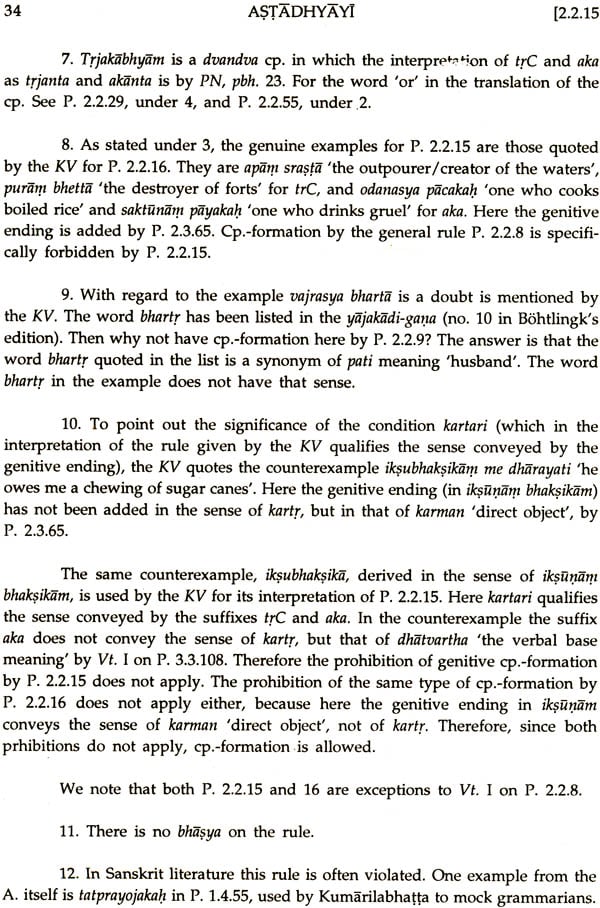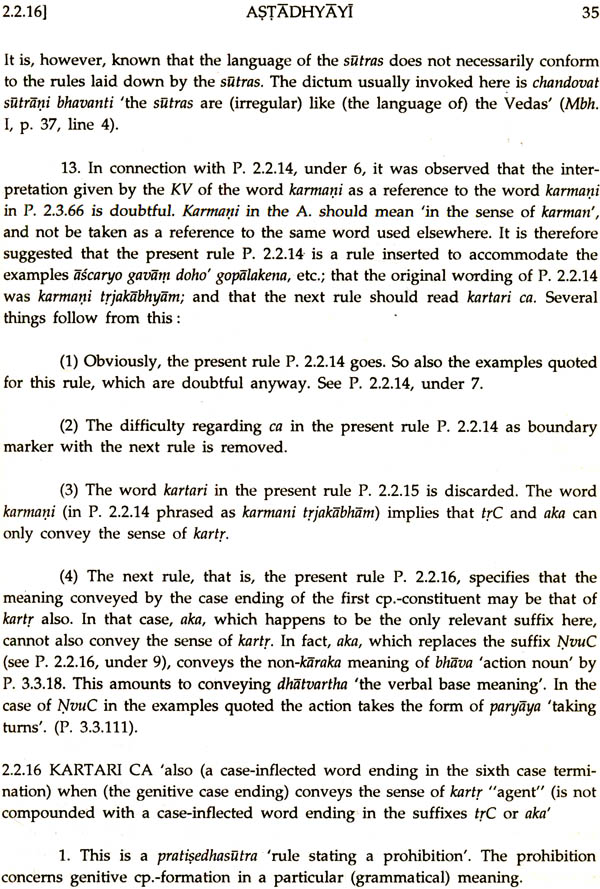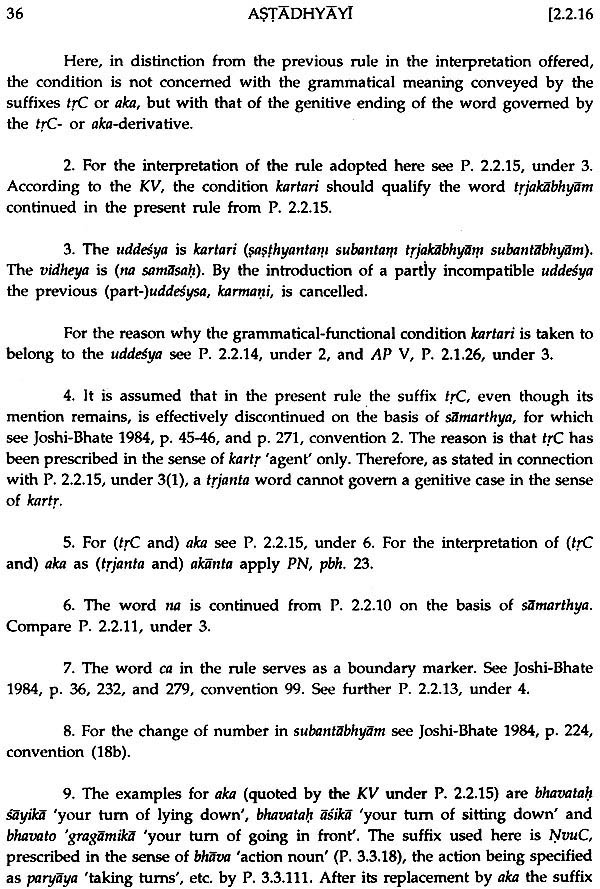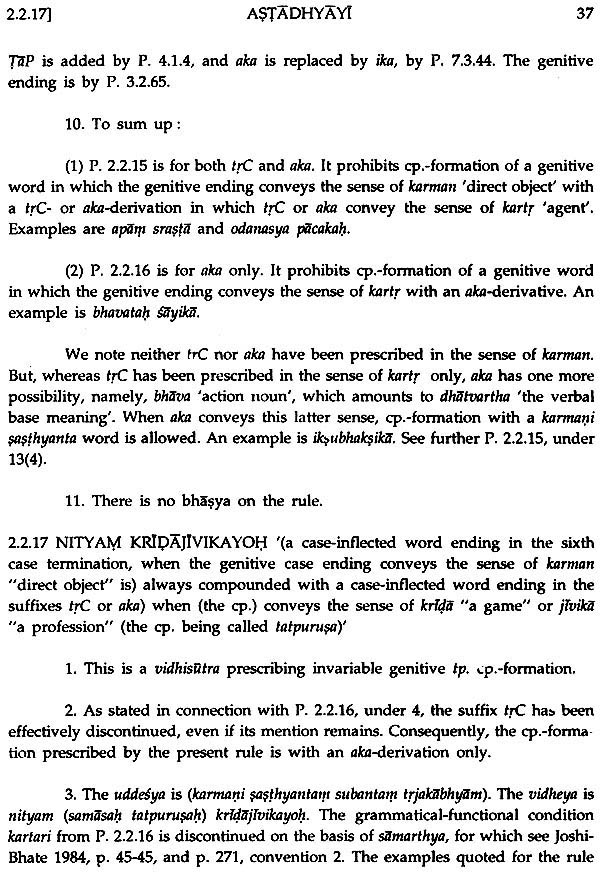
The Astadhyayi of Panini: Volume VI (2.2.1 - 2.2.38)
Book Specification
| Item Code: | IDE656 |
| Author: | Translation & Explanatory Notes By. S.D. Joshi & J.A.F. Roodbergen |
| Publisher: | SAHITYA AKADEMI, DELHI |
| Language: | English |
| Edition: | 1997 |
| ISBN: | 8128003162 |
| Pages: | 132 |
| Cover: | Hardcover |
| Other Details | 10.0" X 7.7" |
| Weight | 510 gm |
Book Description
From the Introduction:
P. 2.2: Survey of the Topics
1. The total number of rules in the standard edition of the A, is 3983. Most rules are found in adhyaya 6 (736 rules), followed by adhyaya 4 (635 rules), adhyaya 3 (631 rules) and adhyaya 5 (555 rules).
The present pada contains the smallest number of rules, 38 only. It is followed by the padas 8.4 (68 rules), 2.1 (72 rules), 1.2 and 2.3 (73 rules) and 1.1 (75 rules).
2. The contents of pada 2 of the second adhyaya can be easily divided into four main sections, as follows:
A. P. 2.2.1-22 : tatpurusa cp.-formation
B. P. 2.2.23-28 : bahuvrlhi cp.-formation
C. P. 2.2.29 : dvandva cp.-formation
D. P. 2.2.30-38 : rules regulating word order in a cp.
3. Section A may be subdivided, as follows:
(1) P. 2.2.1-3 : ekadhikarana tp. Cp.-formation
(2) P. 2.2.4-5 : tatpurusa cp.-formation with particular past participles and substantives
(3) P. 2.2.6-7 : tatpurusa cp.-formation with avyayas
(4) P. 2.2.8-17 : genitive tatpurusa cp.-formation
(5) P. 2.2.18 : tatpurusa cp.-formation with ku, forms called gati and forms listed in the pradi-gana.
(6) P. 2.2.19-27 : tatpurusa cp.-formation with upapadas (bound forms)
4. Section D may be subdivided as follows:
(1) P. 2.2.30 : purvanipata for the cp.-constituent called upasarjana
(2) P. 2.2.31 : paranipata for the constituent called upasarjana as listed in a gana
(3) P. 2.2.32-35 : purvanipata for the cp.-constituent called upasarjana in a dvandva
(4) P. 2.2.35-37 : purvanipata for the cp.-constituent called upasarjana in a bahuvrlhi
(5) P. 2.2.38 : purvanipata for the cp.-constituent called upasarjana in a karmadharaya cp.
5. Viewed in greater detail the break-up of the sections with the subdivisions is as follows:
A. P. 2.2.1-3 share the words ekadesina ekadhikarane '(a cp. Formed) with (a word signifying) a whole having parts, provided that the whole mentioned is one single entity'. The reference of the cp. Thus formed is to a part of that whole. The part is expressed by the first member of the cp. Therefore the reference of the cp. is determined by its first member. One example quoted for P. 2.2.1 is purvakayah 'the front(part) of the body'.
The cps formed by P. 2.2.1-3 look like kdh. cps. But since they express a part-whole relation which linguistically involves a genitive case relation, they are a subclass of genitive tp. Cp.-formation, whose further peculiarity is that the reference of the cp. is determined by its first member.
P. 2.2.1-2 come under the option stated as va 'preferably' by P. 2.1.18. This option is cancelled by the word anyatarasyam 'indifferently' in P. 2.2.3. Obviously, one and the same rule cannot contain two option words. Accordingly, P. 2.2.3 indifferently allows a cp. like dvitiyabhiksa 'the second (portion/share) of alms' and the formally corresponding wordgroup like bhiksayah dvitiyam conveying the same meaning. Tradition, however, wrongly allows three forms, like dvatlya bhiksa, bhiksayah, dvitlyam, and bhiksadvitlyam, the latter form by P. 2.2.8 To have three alternative forms, we require two options. One option is traditionally obtained from P. 2.1.11-12, which is regarded as the general statement of option for cp.-formation. The other option is provided by the word anyatarasyam in P. 2.2.3. The traditional position is the result of the confusion of terms for optionality in the A.
Two examples quoted for P. 2.2.4-5 are praptajlvikah 'who has obtained a livelihood', where prapta has an active meaning, and masajatah 'a month of the born one', tp. Analysis.
Do we continue the option word anyatarasyam in P. 2.2.4, and could that be the purpose of the word ca in the rule? The KV remains silent on both points. Both questions are answered in the negative. For the function of ca four possibilities are mentioned. It is assumed that the only function which can be reasonably attributed to ca is that of being a handy device to append a rule. But that implies that P. 2.2.4 is an inserted rule. It also follows that the option word va is continued again in this rule. This creates a curious problem in connection with the prescription for cp.-formation stated by P. 2.1.24.
In connection with the word katah, in P. 2.2.5 some observations are made regarding the use of the plural in the A. By using the plural in katah, the sutrakara makes it clear that his word is not to be taken as an instance of svarupagarahana 'mention of (the word's) own form' by P. 1.1.68. In fact, katah represents a general term comprising specific words expressing a period of time.









